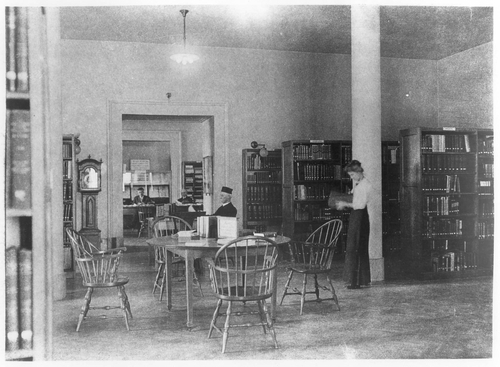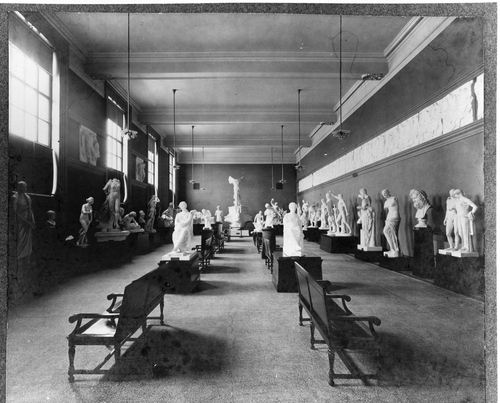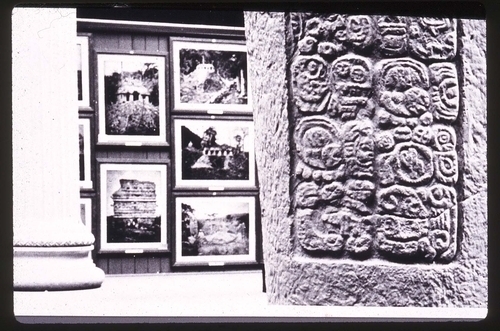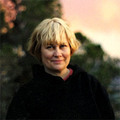The world through Goodyear’s eyes: photographs from the 1890’s to 1923 from the Brooklyn Museum Archives
Seeing the response to historic photographs that we have posted on Flickr Commons begs a look back on why we have these images and who created them. Being an art museum library and archives our mission is to collect and make accessible research collections that serve to document the objects held in the Brooklyn Museum’s encyclopedic collection. We also preserve the research documents created or collected by the Museum staff who have acquired objects since the founding of the Museum as a library back in 1823. What that means is that we have a rich historical legacy of text and images that allow us to look back in time and recall the period in which the objects were created–where, when, how and why.

Susan A. Hutchinson, Founding Museum Librarian, with William Henry Goodyear, Founding Curator of Fine Arts in the Library Reading Room circa 1910.
Since the images collected by William Henry Goodyear (1846-1923) are generating interest today we thought it would interesting to look back at Goodyear and several of his colleagues who built the Museum’s collections over the years. So let’s declare 2009 the year of looking back and learning from history. Hopefully this exercise will educate us all as we move forward and learn about each other and our cultural heritage. Who knows maybe we will end the year in a more peaceful way than we started.
Let me start with a quote from artist John La Farge to William Henry Goodyear: “You have opened the window that has been closed for centuries, and have let in the light”.
I believe that La Farge was referring to Goodyear’s intense interest in photography as a tool to document the world he saw. A Yale graduate and student at the Universities of Berlin and Heidelberg, Goodyear devoted himself to teaching and lecturing about the history of art and architecture. After graduating from Yale in 1867, he traveled to Germany, Italy, Palestine and Syria to pursue his interest in architecture. It was in Pisa in 1870 that he began to focus on architectural details and later published in an article entitled “A Lost Art” in Scribner’s Magazine, the first of many essays he wrote about architectural refinements. Goodyear started his museum career in 1882 as a curator at the Metropolitan Museum of Art and in 1899 came to the Brooklyn Museum as the first curatorial appointment made by the newly founded museum. At Brooklyn, Goodyear led a series of research and collecting expeditions with a mission to build an art collection. He oversaw the growth of the American, European and ancient art collections including the casts of Ancient and Renaissance sculpture as well as designing and installing exhibitions of newly acquired art.

Hall of Sculpture with Casts, circa 1904.
In addition to his curatorial mandate, Goodyear dedicated time to developing his architectural theory that historic buildings were planned with irregularities which he referred to as refinements. This study focused on architectural monuments found around the world from the Cathedral of Pisa to the temples of Egypt with stops in Austria, France, Germany, Great Britain, Greece and Turkey. Like his colleague Stewart Culin, founding curator of Ethnology from 1903 to 1929, Goodyear seems to have been interested in everything and this is evidenced in his photographs of people and places around the world from a street vendor in Istanbul to the vivid depictions of the world fairs of Chicago and Paris. Goodyear recognized the importance of these fairs as an educational tool to introduce cultures from different parts of the world. He, like Culin, also saw objects at the fairs and recommended their acquisition for Brooklyn. These photographs by Alfred Percival Maudslay were exhibited at the Chicago Columbian Exposition and collected for Brooklyn after Goodyear and Culin saw them at the fair. Indeed, Goodyear worked obsessively using photography as a tool to educate and a method to document his findings in the field in addition to his writings.

Maudslay photographs on view in the Chicago Columbian Exposition, circa 1893.
It seems that throughout his long life he developed theories that explored new themes in the history of art starting with his “Grammar of the Lotus” documenting continuing use of the lotus form in decorative art since its use in Ancient Egypt. He also wrote several popular histories of art and was one of the first to use actual photographs, as opposed to engravings, to illustrate these texts. He took and collected photographs and used them in the form of lantern slides to illustrate his many lectures–over 130 for the Brooklyn Museum alone–ranging from the art of ancient civilizations to the art of the nineteenth century. In addition to being known as an architectural historian, Goodyear was a scholar of anthropology, archaeology and ethnology with a focus on America, Egypt, Greece and Rome. All of this is evidenced in the photographs (lantern slides, negatives and prints) and his research (published and unpublished) found in the Museum Libraries and Archives.
His photographs offer detailed images of historic structures before the devastation of world wars and rampant twentieth century architectural “redevelopment.” His documentation of many buildings has served as guideposts to reconstruction of several monuments that have been destroyed or renovated over the years. But his influence went beyond architecture since it was his vision that laid the groundwork for two major art museum collections–the Brooklyn Museum and the Metropolitan Museum of Art. He was responsible for recommending the acquisition of several important objects including the antiquities collection and library assembled by Charles Edwin Wilbour, America’s first Egyptologist. Goodyear also established the first children’s museum in America – the Brooklyn Children’s Museum. Today we all benefit from Goodyear’s scholarship and foresight as we see the world before us through his photographs and writings.
More to come about these early visionaries in Brooklyn, but today we are honoring Professor Goodyear by releasing more images from his archives of street scenes and mosques in Turkey in response to comments on Flickr Commons.

Deirdre Lawrence has been the Principal Librarian at the Brooklyn Museum since late 1983. Before coming to the Brooklyn Museum, she was Associate Librarian at the Museum of Fine Arts in Boston. She received her M. L. S. from Pratt Institute in 1979 and has studied art history on the graduate level. At the Brooklyn Museum she has established the Museum Archives and implemented many projects to preserve and make accessible the research collections. Deirdre has overseen a major renovation project, implementation of an online catalog and several collaborative projects with other libraries. She has written articles on the collections and lectured frequently on the research collections held in the Libraries and Archives as well as Brooklyn Museum history. Deirdre has curated several exhibitions at the Brooklyn Museum and elsewhere. She is a visiting professor at Pratt’s School of Information and Library Science and serves as a board member at the Center for Book Arts in New York.
